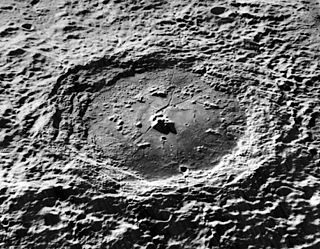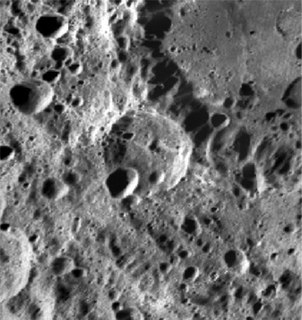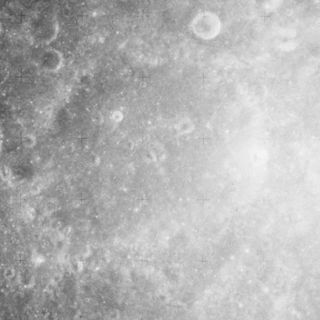
Anaximenes is a low-rimmed lunar impact crater near the north-northwest limb of the Moon. It lies to the west of the crater Philolaus, and northeast of Carpenter. To the northwest is Poncelet, close to the visible edge of the Moon.

Cavendish is a lunar impact crater that is located in the southwest part of the Moon, to the southwest of the larger crater Mersenius. It lies between the smaller craters Henry to the west-northwest and de Gasparis to the east-southeast.

Boss is a lunar impact crater that is located along the northeast rim of the Moon's near side. Due to its location, the crater is viewed from the side by observers on the Earth, and its visibility is subject to libration effects.

Byrd is an irregular lunar impact crater that is located near the north pole of the Moon. The north rim of Byrd is nearly connected to the crater Peary, a formation that is adjacent to the pole. The smaller crater Gioja is attached to the remains of the southwest rim.

Dawson is a lunar impact crater that lies on the southern hemisphere on the far side of the Moon. It lies across a crater triplet: the southeast rim is intruding into the crater Alekhin; the northwest rim also intrudes into the larger satellite crater Dawson V, and the northeast rim is attached to the comparably sized Dawson D. To the south of this formation is the large crater Zeeman. West of Dawson is the crater Crommelin, and to the north lies Fizeau.

Bohr is a lunar impact crater that is located near the western lunar limb, in the area that is affected by librations. It is attached to the southwestern rim of the larger, eroded Vasco da Gama formation, and to the southeast of the crater Einstein. The crater was observed for the first time in 1963 by Arthus and Ewen Whitaker in the book Rectified Lunar Atlas.

Compton is a prominent lunar impact crater that is located in the northern hemisphere on the far side of the Moon. It lies to the east of the Mare Humboldtianum, and southwest of the walled plain Schwarzschild. To the southeast of Compton is the heavily eroded crater Swann.

Borda is a lunar impact crater that lies between Santbech to the north-northwest and Reichenbach slightly further away to the south-southeast. It was named after French astronomer Jean-Charles de Borda. It has a low rim that is broken along the southeast by a smaller crater. The rim is intruded into by another small crater along the southwest side, and there is an irregular cleft along the northwest face. There is a central peak at the midpoint of the floor.

Fabry is a large lunar impact crater of the form termed a walled plain. It is located on the far side of the Moon, just beyond the northeastern limb. Parts of this area are sometimes brought into view by the effects of libration, but the terrain is seen from the edge and so not much in the way of detail can be observed.

Belyaev is a lunar impact crater that is attached to the outer edge of the Mare Moscoviense, on the far side of the Moon. It is a worn formation with a small crater pair overlaying the southern rim, and several smaller craters across the relatively irregular interior.

Bobone is an old, heavily eroded crater formation that lies on the far side of the Moon. Little remains of the original crater formation, leaving only a bowl-shaped depression in the surface that is pock-marked by tiny craterlets. It is attached to the southwest rim of the large satellite crater Kovalevskaya Q, which has its northeast rim overlaid by Kovalevskaya itself. To the west-southwest is Bronk.

Buisson is a lunar impact crater that is located on the far side of the Moon. It is named after the French physicist Henri Buisson. Nearly attached to the southeast rim is the crater Vesalius. To the southwest is Einthoven. The rim of this crater is somewhat worn, and is lowest in the north. There is a low central ridge across the midpoint.

Casatus is a lunar impact crater that is located near the southern limb of the Moon. The north-northeast rim of the crater overlies a portion of the slightly larger crater Klaproth. Along the western rim, Casatus A intrudes somewhat into the interior, producing an inward-bowing rim. To the southeast of Casatus is Newton.

Carnot is a large crater in the northern part of the Moon's far side. It intrudes into the southern rim of the huge walled plain Birkhoff. To the west-southwest of Carnot is the crater Paraskevopoulos.

Chappell is a lunar impact crater that is located on the far side of the Moon, in the northern hemisphere just to the north of the crater Debye. This feature is located in a heavily bombarded section of the surface, and much of the outer rim of the crater is overlain by many smaller craters. The northern rim in particular has been almost completely disintegrated, while small craters also overlie the rim to the northwest and southeast. What remains of the rim forms a rounded, somewhat irregular edge to the crater depression.

Chevallier is a lunar impact crater that is located in the northeastern part of the Moon's near side, about a crater diameter east-southeast of the prominent crater Atlas. To the south-southeast of Chevallier is the flooded crater Shuckburgh.
Dove is a small lunar impact crater that is located in the rugged lunar highlands in the southeastern part of the Moon. It lies to the north of the prominent crater Pitiscus.

Douglass is a lunar impact crater on the far side of the Moon. It lies to the southwest of the crater Frost and south-southwest of the large walled plain Landau.

Espin is a lunar impact crater that lies on the far side of the Moon, just beyond the northeastern limb. It lies to the west-southwest of the larger crater Seyfert, and northwest of Deutsch.

Fleming is a large lunar impact crater that is located on the Moon's far side, and cannot be seen from the Earth. It lies about a crater diameter to the east-northeast of Hertz, and to the northwest of Lobachevskiy.
























